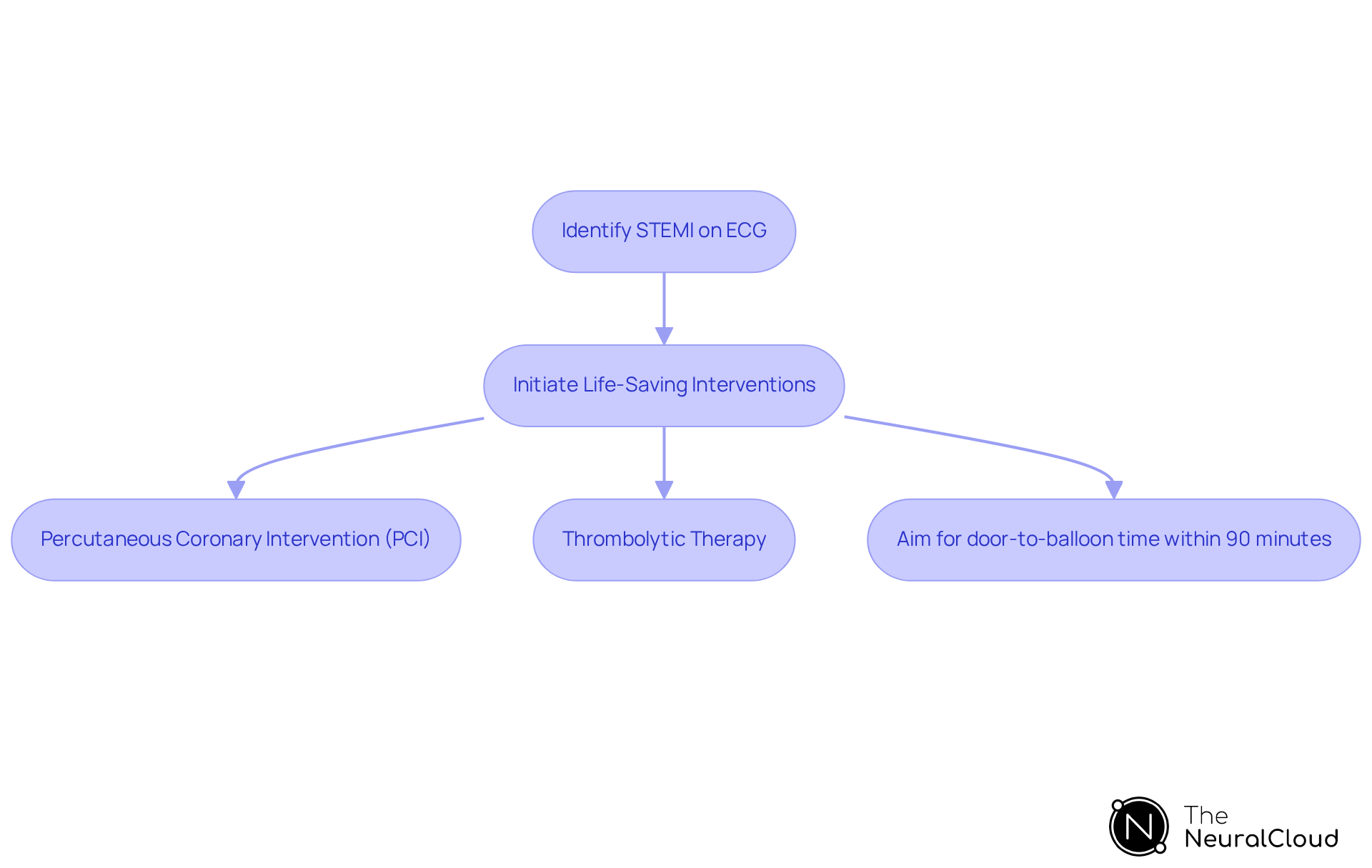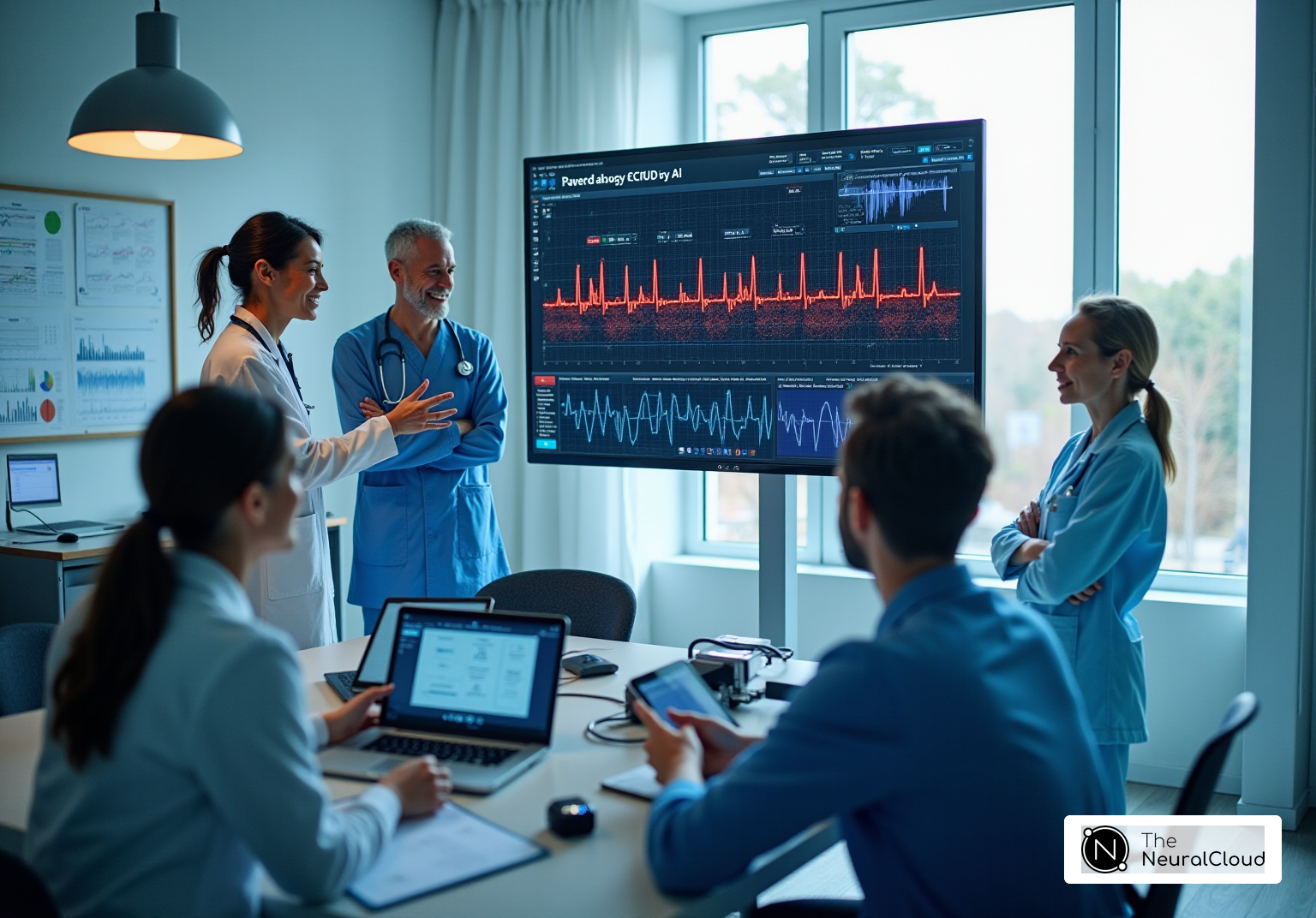Overview
The article delves into the challenges faced in the identification and analysis of ST-elevation myocardial infarction (STEMI) on ECG. Accurate ECG interpretation is crucial, as timely diagnosis and intervention can significantly impact patient outcomes. However, traditional methods often struggle with noise and complexity, making it difficult for healthcare professionals to make swift decisions.
Enter the MaxYield™ platform, a game-changer in ECG analysis. This advanced technology automates the analysis process, effectively reducing noise and enhancing the clarity of critical patterns. By streamlining the identification of STEMI, MaxYield™ empowers healthcare professionals to act quickly and confidently, ensuring that patients receive the timely care they need.
The features of the MaxYield™ platform include:
- Automated ECG analysis
- Noise reduction
- Enhanced decision-making capabilities
These features not only simplify the diagnostic process but also improve accuracy, allowing for better identification of STEMI cases. As a result, healthcare professionals can rely on MaxYield™ to support their clinical decisions, ultimately leading to improved patient outcomes and higher survival rates.
In summary, the MaxYield™ platform addresses the pressing challenges in ECG analysis by offering innovative features that enhance diagnostic accuracy. The advantages for healthcare professionals are clear: improved efficiency, reduced errors, and better patient care. By leveraging this technology, clinicians can focus on what truly matters—providing exceptional care to their patients.
Introduction
ST-elevation myocardial infarction (STEMI) is a critical emergency in cardiovascular health, marked by a significant elevation in the ST segment on an ECG. This elevation indicates a complete blockage of a coronary artery, making timely recognition and intervention crucial for improving patient outcomes and reducing mortality rates. Despite advancements in technology and diagnostic tools, many clinicians still face challenges in accurately identifying and interpreting these vital ECG patterns.
Understanding the nuances of STEMI is essential for healthcare professionals. The complexities of ECG analysis can lead to misinterpretations, which may delay necessary treatment. Therefore, exploring key strategies and technologies that enhance the detection and analysis of STEMI on ECG is vital. These advancements not only improve diagnostic accuracy but also have the potential to save lives.
Define STEMI and Its Clinical Importance
ST-elevation myocardial infarction, or STEMI on ECG, is a critical type of heart attack marked by a significant rise in the ST segment, indicating a complete blockage of a coronary artery. This condition is clinically significant, as it can lead to severe heart damage if not treated immediately. Identifying a myocardial infarction on an ECG is essential for healthcare providers, enabling them to initiate life-saving interventions such as percutaneous coronary intervention (PCI) or thrombolytic therapy within a crucial time frame. Timely treatment can greatly enhance patient outcomes, reducing the risk of complications and mortality.
For instance, the national average door-to-balloon time for heart attack treatment is 90 minutes. However, facilities like Piedmont hospitals achieve an average of only 60 minutes, underscoring the importance of swift action. Immediate restoration of blood flow is vital to minimize heart muscle damage, as delays can result in irreversible harm and conditions like cardiogenic shock. Experts highlight that cardiac arrest is a leading cause of mortality in cases of STEMI on ECG, emphasizing the urgency of prompt diagnosis and treatment.
The integration of wearable technology with Neural Cloud Solutions' MaxYield™ platform significantly enhances the effectiveness of ECG evaluation. This platform automates labeling and data extraction, allowing healthcare professionals to focus on critical decision-making tasks. Key features of the MaxYield™ platform include:
- Automated ECG labeling
- Efficient data extraction
- Enhanced decision-making support
These features lead to improved ECG analysis accuracy, addressing challenges such as physiological variability and signal artifacts. The Continuous Learning Model further refines ECG analysis by evolving with each use, ensuring that healthcare providers have the most accurate information at their fingertips.
Understanding the clinical implications of myocardial infarction not only aids in prioritizing patient care but also optimizes resource allocation in emergency settings. This ultimately contributes to improved survival rates, making the MaxYield™ platform an invaluable tool for healthcare professionals.

Identify Key ECG Patterns of STEMI
Key ECG patterns indicative of STEMI include:
-
ST Segment Elevation: This is the most critical feature for diagnosing STEMI, typically observed in two or more contiguous leads. A significant elevation of 1 mm or more in limb leads and 2 mm or more in precordial leads is essential for diagnosis. In men, ST segment elevation of at least 2 mm in contiguous leads is indicative, while in women, it is at least 1.5 mm in V2 and V3 leads or 1 mm in other leads. The MaxYield™ platform enhances the detection of these critical elevations by mapping ECG signals through noise, ensuring that clinicians can confidently identify these patterns, including P-wave, QRS complex, and T-wave onsets and offsets.
-
Reciprocal Changes: ST segment depression in leads opposite to the area of elevation can provide additional diagnostic clues, enhancing the precision of myocardial infarction identification. With MaxYield™, these mutual adjustments are clearly shown, enabling quick evaluation and improved clinical decision-making.
-
Q Waves: The development of pathological Q waves may occur hours to days after the onset of STEMI, indicating myocardial necrosis and serving as a late marker of infarction. The MaxYield™ system supports the identification of these changes through its beat-by-beat analysis, providing detailed insights into the evolving ECG patterns.
-
T-Wave Changes: Inverted T-waves may also be observed in the affected leads as the condition evolves. Recognizing these patterns is vital for prompt intervention, as they can indicate ongoing ischemia or infarction. MaxYield™ aids in transforming noisy recordings into clean waveforms, facilitating the recognition of these critical changes.
Recent studies highlight that STEMI on ECG indicates ST elevation myocardial infarction, which represents roughly 30% of all acute coronary syndrome cases, emphasizing the prevalence and critical nature of timely diagnosis. Clinicians must stay alert for unusual presentations and new ECG patterns that may suggest life-threatening conditions, as prompt intervention can greatly lower mortality rates linked to this type of heart attack. Moreover, recent revisions to the European Society of Cardiology guidelines emphasize the significance of identifying a wider range of myocardial infarction presentations, including equivalents of the condition. As Dr. Robert Herman noted, "By recognizing complex patterns or subtle deviations that could indicate a coronary event, AI can augment clinical decision-making in chest pain patient cohorts." This underscores the necessity for healthcare professionals to stay informed about evolving diagnostic criteria and the significance of timely intervention, a process that can be greatly enhanced through the use of MaxYield™.

Analyze STEMI ECG Cases: A Step-by-Step Approach
To effectively analyze STEMI ECG cases, follow these systematic steps:
-
Obtain a Clear ECG Recording: Ensure the ECG is free from artifacts and noise, as these can significantly hinder accurate interpretation. Studies indicate that up to 7.6% of ECG recordings may be non-analyzable due to impactful non-physiological artifacts, underscoring the importance of quality control in ECG analysis.
-
Identify the Leads: Focus on leads exhibiting ST segment elevation, noting the degree of elevation. This is vital, as the presence of ST elevation is a primary sign of a heart attack.
-
Look for Reciprocal Changes: Investigate for ST segment depression in leads that are anatomically opposite to those showing elevation. This reciprocal change can provide additional confirmation of myocardial ischemia.
-
Assess for Q Waves: Evaluate the presence of Q waves, which may signify myocardial damage. The emergence of Q waves can indicate a more advanced stage of myocardial infarction.
-
Consider Clinical Context: Correlate ECG findings with the patient's symptoms and medical history to substantiate the diagnosis. This holistic approach is essential for accurate interpretation and effective patient management.
By adhering to these optimal methods, healthcare professionals can enhance their diagnostic precision in heart attack cases. Recent research has demonstrated that systematic methods in ECG evaluation, especially those employing AI-boosted techniques, can greatly improve sensitivity and specificity in identifying acute myocardial infarction, decreasing false activations from 42% to merely 8%. As Timothy D. Henry, MD, FACC, noted, 'These results indicate that AI-enhanced diagnosis of stemi on ecg at the first medical contact has the potential to shorten time to treatment and reduce false activations.' Furthermore, the AI ECG model demonstrated an area under the curve (AUC) of 0.94, reinforcing the effectiveness of systematic approaches in modern cardiology.

Leverage Advanced Technologies for Enhanced ECG Analysis
Advanced technologies, such as Neural Cloud Solutions' MaxYield™ platform, address significant challenges in ECG analysis through several key innovations:
- Automated Signal Processing: MaxYield™ employs AI algorithms that efficiently detect and label critical features of the ECG. This automation drastically reduces the time needed for manual analysis, allowing healthcare professionals to focus on interpreting results rather than spending excessive time on data entry. The platform can analyze 200,000 heartbeats in less than 5 minutes, showcasing its efficiency and effectiveness in clinical settings.
- Device-Agnostic Capability: The system is designed to be device-agnostic, seamlessly capturing ECG recordings from any 1-lead or 3-lead device. This flexibility enhances usability across various clinical environments, making it a versatile tool for healthcare providers.
- Noise Reduction: Utilizing advanced filtering techniques, this system minimizes the impact of noise and artifacts, thereby improving the clarity of ECG signals. This capability is crucial, as noise can obscure vital information, leading to misinterpretations. The platform's noise filtering, paired with P, QRS, and T Wave highlighting, has demonstrated a C statistic of 0.97 against standard 12-lead ECG, underscoring its superior noise reduction capabilities.
- Real-Time Analysis: The platform's ability to process large volumes of data rapidly enables immediate feedback and decision-making in critical situations. This real-time capability is essential for timely interventions, particularly in emergency settings where every second counts. AI-enhanced ECG evaluation has shown significant advancements in identifying myocardial infarction, particularly through the detection of stemi on ecg, which can be life-saving.
- Continuous Learning: The machine learning models employed by MaxYield™ adapt and improve over time, enhancing diagnostic accuracy and efficiency. This ongoing learning process ensures that the platform remains at the cutting edge of ECG assessment technology, providing healthcare professionals with dependable data for informed decision-making. Dr. Anthony C. Pearson observed that AI-enhanced ECG evaluation has the potential to significantly enhance patient care, highlighting the necessity of incorporating such technologies into clinical practice.
By leveraging these advanced technologies, including the device-agnostic nature and adherence to Gold Standard Methodologies, healthcare providers can significantly improve patient outcomes through more accurate and efficient ECG analysis.

Conclusion
ST-elevation myocardial infarction (STEMI) is a critical medical emergency that requires immediate recognition and intervention. Accurately identifying STEMI on an ECG is essential for healthcare professionals, as timely treatment can significantly reduce heart damage and enhance patient survival rates. Advanced technologies, like the MaxYield™ platform, improve diagnostic accuracy and efficiency, facilitating quicker and more reliable decision-making in emergency situations.
This article explores key ECG patterns indicative of STEMI, such as:
- ST segment elevation
- Reciprocal changes
- T-wave alterations
Each pattern offers vital insights that assist clinicians in effectively diagnosing and treating myocardial infarction. Additionally, the systematic approach to ECG analysis emphasized in the article highlights the importance of quality control and the use of advanced technologies to minimize diagnostic errors and enhance patient outcomes.
Given the urgent nature of STEMI and the advancements in ECG analysis, it is crucial for healthcare professionals to stay updated on current guidelines and technological innovations. By utilizing tools like MaxYield™, clinicians can bolster their diagnostic capabilities, ultimately leading to improved patient care and higher survival rates in cases of acute myocardial infarction. The message is clear: prioritize education on STEMI recognition and leverage cutting-edge technology to ensure timely, life-saving interventions.
Frequently Asked Questions
What is STEMI and why is it clinically important?
ST-elevation myocardial infarction (STEMI) is a critical type of heart attack characterized by a significant rise in the ST segment on an ECG, indicating a complete blockage of a coronary artery. It is clinically important because it can lead to severe heart damage if not treated immediately.
How does timely treatment affect outcomes for STEMI patients?
Timely treatment can greatly enhance patient outcomes by reducing the risk of complications and mortality. Immediate restoration of blood flow is vital to minimize heart muscle damage, as delays can result in irreversible harm.
What is the national average door-to-balloon time for heart attack treatment?
The national average door-to-balloon time for heart attack treatment is 90 minutes. However, some facilities, like Piedmont hospitals, achieve an average of only 60 minutes.
What are the risks associated with delays in treating STEMI?
Delays in treating STEMI can result in irreversible heart damage and complications such as cardiogenic shock. Cardiac arrest is a leading cause of mortality in cases of STEMI, emphasizing the urgency of prompt diagnosis and treatment.
How does the MaxYield™ platform enhance ECG evaluation?
The MaxYield™ platform integrates wearable technology to enhance ECG evaluation by automating labeling and data extraction, allowing healthcare professionals to focus on critical decision-making tasks.
What are the key features of the MaxYield™ platform?
Key features of the MaxYield™ platform include automated ECG labeling, efficient data extraction, and enhanced decision-making support, which improve ECG analysis accuracy and address challenges like physiological variability and signal artifacts.
How does the Continuous Learning Model benefit ECG analysis?
The Continuous Learning Model refines ECG analysis by evolving with each use, ensuring that healthcare providers have access to the most accurate information for decision-making.
Why is understanding myocardial infarction important for healthcare providers?
Understanding the clinical implications of myocardial infarction aids healthcare providers in prioritizing patient care and optimizing resource allocation in emergency settings, ultimately contributing to improved survival rates.






